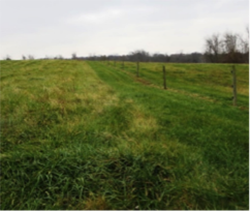Stockpiling Fescue
 This past winter the Master Grazer Educational program conducted several stockpiling demonstrations across KY for producers to see the benefits of extending the grazing season using stockpiled fescue. One of these demonstrations was implemented in Oldham County by producer Dr. Maynard Stetton. He has completed the Master Grazer and Master Cattleman programs and has been implementing stockpiling fescue on his farm for several years, and was eager to see the impact adding nitrogen could have. His operation consists of a registered Angus cow/calf herd.
This past winter the Master Grazer Educational program conducted several stockpiling demonstrations across KY for producers to see the benefits of extending the grazing season using stockpiled fescue. One of these demonstrations was implemented in Oldham County by producer Dr. Maynard Stetton. He has completed the Master Grazer and Master Cattleman programs and has been implementing stockpiling fescue on his farm for several years, and was eager to see the impact adding nitrogen could have. His operation consists of a registered Angus cow/calf herd.
The Oldham County extension agent, Traci Missun, worked with Dr. Stetton on laying out the individual paddocks, water access, and getting nitrogen applied in August to a 14-acre pasture. The field was clipped to a height of 4 to 6 inches in August and Traci calculated that this cost $11.50/acre. They applied 40 lbs. of actual nitrogen per acre to the selected field, except in a 20-foot-wide strip the length of the field along the fence as a comparison. Dr. Stetton had a permanent watering tank on the end of the field where he started grazing.
On November 13, forage samples were taken to determine quality and yield of the stockpiled fescue. Cattle were then turned into the first paddock on November 14. There were 24 heifers which averaged 671 pounds. The cattle were taken out of this pasture on December 30, 2014. Dr. Stetton was able to graze this group of heifers for 46 days without feeding any hay. Free-choice mineral was available at all times, but no other supplementation was provided.
The stockpiled fescue that had nitrogen applied produced on average 1464 lbs. more dry matter (DM) than the fescue that had not received any nitrogen. After calculating the available DM and the stocking density, Traci was able to calculate the number of grazing days nitrogen provided, as well as the portion without nitrogen. The results suggested that with nitrogen, Dr. Stetton should have been able to graze an additional 21 days compared to not adding nitrogen.
A field day was held in December where Dr. Stetton told the group how pleased he was with the results from the demonstration. He said that in his previous experience he had always fertilized in the spring to soil test recommendations, but never added nitrogen in the fall. After seeing the results he was shocked to see the difference that a late summer application of nitrogen made in forage yield. He told the group that simply by looking at the field he couldn’t tell any benefit from the added nitrogen, but after looking at the data he was convinced it had.
Not only did the stockpiled fescue extend the grazing season for Dr. Stetton, it provided a higher quality forage when compared to average fescue hay. The crude protein percentage for the stockpiled fescue was 12.7%, and normal fescue hay is 7-10%. The TDN percentage for the stockpiled fescue tested 57%, and fescue hay ranges from 48-55% TDN. The requirements for a mature beef cow in early lactation are 60% TDN and 11% CP. The stockpiled fescue is able to provide a cow with enough nutrients that supplementation is kept at a minimum. However, as winter progresses, the quality of the stockpiled fescue would slightly decline as it gets weathered and damaged from winter conditions.
Having to feed fewer bales of hay during the winter is something most producers would like to achieve with little expense. Traci determined the fertilized stockpiled fescue cost $70 an acre when considering costs to land, labor, and fertilizer. Assuming hay can be bought at roughly $35 for an 800-1000lb roll bale, then grazing stockpiled fescue will save 50% of the cost of feeding hay. By looking at these numbers it is cheaper to stockpile fescue, and it provides a better quality forage than most stored hay.
In conclusion, this demonstration showed that stockpiled fescue was better than average quality fescue hay. Cattle may require less supplementation versus feeding hay. By feeding less hay, the producer saved on fuel cost and the wear and tear on his tractor. For more information on stockpiling fescue, see your local extension agent or the UK publication Stockpiling for Fall and Winter Pasture.
Categories:
Fall
Extending the Grazing Season


